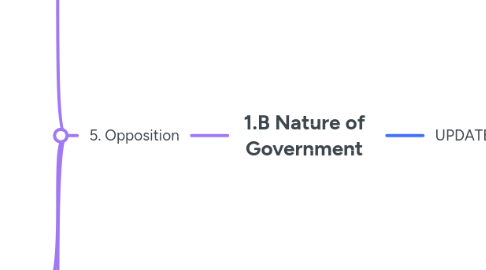
1. 5. Opposition
1.1. Opposition Under the Tsars
1.1.1. Political
1.1.1.1. Narodniks
1.1.1.1.1. Influenced by people like Kar Marx
1.1.1.1.2. This opposition failed because it was divided
1.1.1.2. Peoples Will
1.1.1.2.1. Terrorist group which emerged out of the land and liberty movement
1.1.1.3. SR's
1.1.1.3.1. Emerged from Narodniks and aimed to improve living conditions for the poor population
1.1.1.3.2. It did however manage to murder 2000 politicians including Stolypin and Grand Duke Sergei
1.1.1.4. SD's
1.1.1.4.1. Influenced by Marx's ideology and emphasised need for working class consciousness
1.1.1.5. Kadets or Octobrists
1.1.1.5.1. Octobrists were loyal to the tsar and supported october manifesto
1.1.1.6. No opposition was successful
1.1.1.6.1. All was too divided and faced a powerful state with strong repression
1.1.2. Peasants
1.1.2.1. Emancipation edict
1.1.2.1.1. Peasants revolted because of unhappiness with terms
1.1.2.2. Black Earth Region Revolts (1906)
1.1.2.2.1. Stolypin introduced repression into the area including the execution of peasants to reduce the strikes, he also abolished redepemption payments which could suggest the revolts had an element of effectiveness
1.1.2.3. During WW1 Peasants siezed land from landowners in the biggest land grab in history
1.1.3. Workers
1.1.3.1. Bloody Sunday Strikes
1.1.3.1.1. Repressed with the army, but did result in the October Manifesto
1.1.3.2. 1912 Lena Goldfied strike
1.1.3.2.1. Strike Repressed with the army with 200 killed
1.1.3.3. 1917 Pulitov strikes
1.1.3.3.1. These effectively began the February revolution which ended tsarism
1.2. Opposition Under Provisional Government
1.2.1. Bolsheviks gained the support of the petrograd garrison (MRC)
1.2.1.1. Membership had grown to 250,000 by 1917
1.2.1.1.1. They now had military provision
1.3. Opposition Under Communists
1.3.1. Lenin
1.3.1.1. Political
1.3.1.1.1. Left wing bolsheviks
1.3.1.2. This opposition was inneffective
1.3.1.2.1. Ban on factions meant there was no room for debate over Lenin's policies
1.3.2. Stalin
1.3.2.1. Political
1.3.2.1.1. Trotskys 'revolution betrayed' book
1.3.2.2. Peasants
1.3.2.2.1. Collectivisation
1.3.2.3. Opposition was inneffective as Stalins use of terror, repression and show trials effectively killed opposition
1.3.2.3.1. Workers were forced to accept Stalins 5 year plans
1.3.3. Khrushchev
1.3.3.1. Political
1.3.3.1.1. The party did successfully coup and remove him from power in 1964
1.3.3.1.2. Old Stalinists (The Old Party Group)
1.3.3.2. Workers
1.3.3.2.1. Novocherkassk Protest (1962)
1.3.3.3. Peasants
1.3.3.3.1. Khrushchev received little opposition from presants as he had a background in peasantry
2. UPDATED 4. Reform
2.1. Tsars
2.1.1. Used reformation to control the population
2.1.1.1. Emancipation of the serfs and October Manifesto
2.1.2. No tsar opposed reform, they all made economic, institutional and peasantry reforms
2.1.3. Nicholas II was forced to make concessions to keep power and autocracy
2.1.3.1. He had to create the Duma
2.2. Communists
2.2.1. Lenin did not change his approach once he came to power
2.2.1.1. He implemented Ban on Factions to allow for opposition to not legally exist
2.2.2. Like the tsars, communists made concessions
2.2.2.1. Most notably the NEP to maintain the regime and keep support of moderat Bolsheviks
2.2.3. Unlike the Tsars, Lenin made no political concessions
2.3. Tsars
2.3.1. Economic
2.3.1.1. Alexander II and Nicholas II promoted railway construction
2.3.1.1.1. Sergei Wittes great spurt fully comitted to industrialisation and railway growth
2.3.1.2. Alexander II's emancipation edict of 1861
2.3.1.2.1. Alexander III's land captains in 1889 monitored peasant activity
2.3.1.3. Stolypin reform
2.3.1.3.1. Peasants who continued to strip farm where encouraged to form small holding khutar or ortub farms
2.3.2. Political
2.3.2.1. 1861 Emancipation edit and 1864 introduction of zemstva
2.3.2.1.1. Likewise Nicholas IIs introduction of the duma ollowing the impact of bloody sunday and russo japanese war revolutionised the political system
2.4. Communists
2.4.1. Economic
2.4.1.1. War communisms nationalisation programme under lenin and NEP were forms of reform that were intended to centralise control
2.4.1.2. Krushchev hosuing reforms with 108 million moving into krushchyovkas under his rule
2.4.2. Political
2.4.2.1. Creation of a one party state that didnt often change under the three communists
